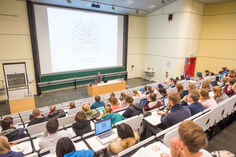Medizinische Zellbiologie - Dr. Amira-Talaat Moussa
Research Summary
Gephyrin is a scaffolding protein involved in assembling inhibitory postsynaptic receptors. Its classical role is to form a lattice-like structure, where Glycine and GABA receptors cluster. Recent research has extended our understanding of GABA inhibitory neurotransmitter functions beyond the nervous system, highlighting its implications in cancer biology. It has been associated with cancer promotion in cases of pancreatic and breast cancer.
Gephyrin, as well has emerged as a significant player that may affect cancer development. However, its precise role in cancer remains unclear. Earlier studies indicate that Gephyrin may exert a tumor-suppressive function by inhibiting the mTOR signaling pathway, which is commonly overactive in cancer. The mTOR pathway critically regulates cancer cell growth, proliferation, and survival.
Our research focuses on exploring the molecular mechanisms of Gephyrin and its interactions with various cellular pathways implicated in cancer. Understanding these mechanisms could unveil new therapeutic strategies exploiting Gephyrin-mediated pathways for cancer treatment.
Curriculum Vitae
2008 Bachelor of Veterinary Medicine, Zagazig University, Egypt
2012 Master of Veterinary Pathology, Zagazig University, Egypt
2012 Visiting scientist in the Biomedical department in Western College of Veterinary Medicine (WCVM), University of Saskatchewan, Canada
2015-2016 Researcher in Anatomy and Cell Biology department, Homburg Medical Faculty, Saarland University, Germany
2017-2022 PhD of Veterinary Medicine, Ludwig-Maximilians-University LMU-Munich/ in collaboration with German Cancer Research Center (DKFZ)-Heidelberg, Germany
2022 Lecturer of Veterinary Pathology, Zagazig University, Egypt
since 2024 Postdoc in Medical Cell Biology department, Institute of Anatomy and Cell Biology, Heidelberg University, Germany
Publications
Moussa AT, Cosenza MR, Wohlfromm T, Brobeil K, Hill A, Patrizi A, Müller-Decker K, Holland-Letz T, Jauch A, Kraft B, Krämer A (2023): STIL overexpression shortens lifespan and reduces tumor formation in mice, doi: https://doi.org/10.1101/2023.12.04.569842.
Moussa AT (2022): Role of STIL overexpression in supernumerary centriole formation, chromosomal instability and cancer development in mice. Dissertation, Faculty of Veterinary Medicine, Ludwig-Maximilians-Universität (LMU)-München, doi: https://edoc.ub.uni-muenchen.de/29529/.
Moussa AT, Rabung A, Reichrath S, Wagenpfeil S, Dinh T, Krasteva-Christ G, Meier C, Tschernig T (2017): Modulation of macrophage phagocytosis in vitro-A role for cholinergic stimulation? Ann Anat. 214:31-35, doi: https://doi.org/10.1016/j.aanat.2017.07.007.
Reichrath S, Reichrath J, Moussa AT, Meier C, Tschernig T (2016): Targeting the non-neuronal cholinergic system in macrophages for the management of infectious diseases and cancer: challenge and promise. Cell Death Discovery 2, 16063, doi: https://doi.org/10.1038/cddiscovery.2016.63.
Moussa AT, Singh B, Al-Dissi AN (2015): Immunohistochemical expression of Nrf2 (Nuclear factor-erythroid 2-related factor 2) and heme-oxygenase-1 in normal and Mannheimia haemolytica infected bovine lungs. Canadian Journal of Veterinary Research, 79(2):81-86. PMID: 25852222; PMCID: PMC4365710.
Open positions
Our Gephyrin project offers opportunities for a 6-month research training for undergraduate students, as well as thesis research for master’s and Ph.D. students, provided they have their own scholarships.




